A) Project Briefing for Clean Water Project –
Background:
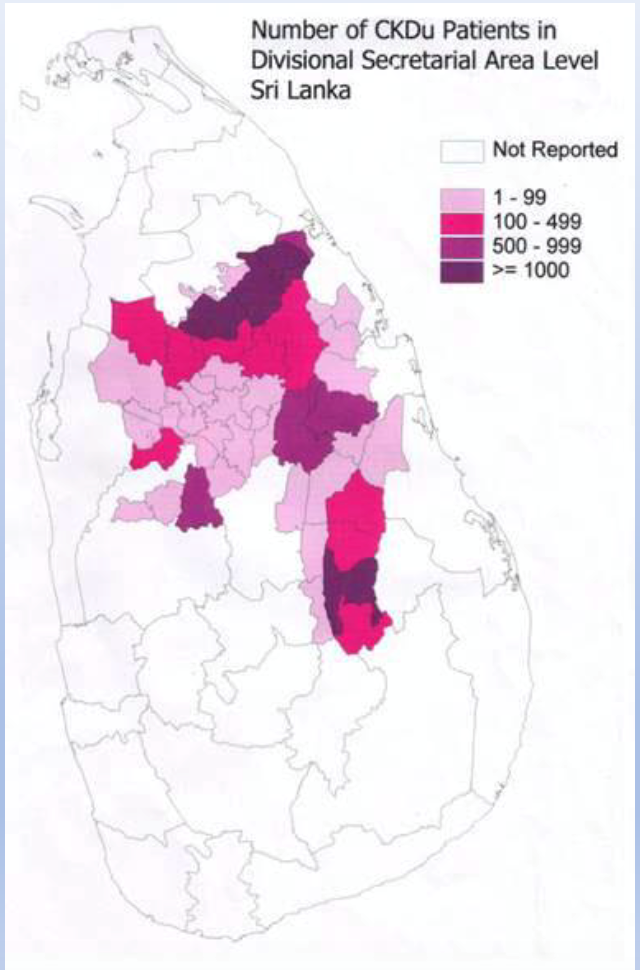
No. of Chronic Kidney Disease patients by area
In Feb 2016, Sis Lim Shu Yin proposed to the FFM committee to undertake the Reverse Osmosis Project for the Sri Lanka.
In Sri Lanka, around 66% of the population depends on local sources such as wells, hand pump tube wells, small scale rural water supply schemes, rain water harvesting tanks and surface water bodies irrigation tanks, canals, streams and springs for their drinking water. The recent increase in the number of persons suffering from renal disease is one of the major health problems in Sri Lanka. Since 1994, a new form of Chronic Kidney Disease, known as CKDu, has been identified in Sri Lanka, which has causes that are not yet understood. According to the Annual Health Bulletin 2005, the hospital mortality rate for diseases of urinary system (which includes kidney diseases) doubled during the period 1980-2005, from 3.1 to 6.5 deaths per 100,000 persons. At the national level, such diseases were the 11th leading cause of hospital deaths in 2005.
In Feb 2016, Sis Lim Shu Yin proposed to the FFM committee to undertake the Reverse Osmosis (RO) Project for the Sri Lanka.
Our partner in Sri Lanka
Sri Lanka Navy is the first organization which deal with RO plants since 1990. At the moment Sri Lanka Navy is handling more than 100 RO plants in various capacities. ( 5 TPD to 40 TPD plants)
Installation and Commissioning: Installation & Commissioning will done be by Sri Lanka Navy staff at free of cost.
Training: Training will be conducted by Sri Lanka Navy staff at the site.
Warranty: 2 years warranty will be provided for high pressure pump and repairs and maintenance support will provide from Sri Lanka Navy for one year at free of cost.
Design Basis
- 24 Hours Operation
- 10 Tons per day
The components of block diagram are indicated down below to easy understanding.

Technical Specifications
a) Feed Pump: The pre-filter is designed to supply sea water to the filter pump at sufficient pre-pressure and consists of a centrifugal pump.
- Specification of pump
(a) Type – Self Priming Pump
(b) Designed flow – 200 LPH
(c) Designed Head – 18 m
(d) Rotation – 2900 RPM
(e) Pressure – 3 bar
- Specification of Drive
(a) Out Put – 0.55 KW
(b) Volts – 415V, 3Phase
(c) Frequency – 50 Hz
(d) Full Load Current – 1.77 A
(e) Speed – 2900 RPM
(f) Insulation – Class “F”
b) Sand Filter: The Sand filter contains 4 layers of Sand namely Coarse, Medium, Fine and Superfine. The Coarse Sand is at the bottom supporting the medium sand then fine sand and the superfine sand which is the top most layer. Superfine and fine layer is the filtering layer while the rest two layers are supporting. It is collected from bottom through a central tube and strainer. The sand filter top layers can get chocked with fine debris etc. This causes more pressure drop across sand filter. Sand filter can be back washed with air and sea water/feed water by flow of the same in opposite direction. The sand filter unit is designed for rapid filtration of the sea /feed water with back washing facility. The filter system is supplied with gauges and diverter valves. Rising of sand filter to be done using permeate water.
Specifications
(1) Material Vessel – FRP
(2) Vessel diameter – 334 mm
(3) Vessel height – 1390 mm
(4) Vessel Volume – 105 liters
(5) Working pressure – 6-8 bar
(6) Filter media – Quartz Sand
(7) No of vessels – 03 No’s
c) Cartridge Filter: The cartridge filter is designed to remove any suspended matter to reduce organic or inorganic fouling on the membranes. The cartridge filter is supplied with sufficient pre-pressure from the filter pump. The filter elements have to be replaced after reaching the maximum allowable pressure drop of 2-2.5 bar. The operation time of the elements depends on the quality of raw water and the extent of pollution in the feed water.
Specifications
(1) Material vessel – PP
(2) Type filter element – Spun
(3) Filter element per vessel – 1
(4) Operating pressure – 3-4 bar
(5) Connection of flange – 0.75” BSP(F)
(6) Filtration grade – Micron 20
(7) Quantity of cartridge filter housing – 04 No’s
Note – This filter element has to be replaced time to time.
d) Activated Carbon Filter (Dolomite Filter): This particular name can be changed as per propose brand name for the RO plant. The normal feed water contains carbonates in small percentage. During reverse osmosis process these carbonates break up and generate CO2 which passes over to the permeate side. This Carbon Dioxide will combine with water and from carbonic acid. Hence to prevent the corrosion of product water following coated iron pipes acidification filter is installed. This filter converts free CO2 back into Ca+ and HCO3– due chemical reaction. (Dolomite should be changed after one year).
Specifications
(1) Vessel Type – FRP 1054
(2) Vessel Diameter – 257 mm
(3) Vessel Height – 1390 mm
(4) Dolomite Size – 20-25 mm grade 4-5
(5) Dolomite weight – Not more than 75 kgs
(6) Operating pressure – 10 bar
(7) Vessel Quantity – 02 No’s
e) High Pressure Pump System: The high pressure pump system consists of 1 no of centrifugal pump. The HP pump is designed to supply raw water to the DT module with sufficient pressure.
- Specifications of pump
(a) Designed flow – 780 LPH
(b) Designed Head – 212 m
(c) Quantity – 01 No
(d) Pressure – 7-85 bar
(e) Speed – 900 rpm
- Specifications of Drive
(a) Out Put – 2.2KW/ 2.8Amp
(b) Volts – 415 volts, 3 Phase
(c) Frequency – 50 Hz
(d) Speed – 1500 rpm
(e) Insulation class – F
f) Spiral Wound Modules: Spiral wound elements have become the most popular and economical form of packaging reverse osmosis (RO) and nanofiltration (NF) membranes. The reason is a result of the high membrane packing area that can be achieved, the efficient water flow and mass transfer in the element, and the low-cost of the materials that are used to construct the element. The basic components of a spiral wound element are the flat sheet membrane, the feed-brine spacer, the permeate carrier, the leaf adhesives, the seal carrier (also called the anti-telescoping device [ATD]), the product water tube, and the epoxy outer shell. Over the past twenty years, the design and materials of the spiral wound element have slowly been optimized to enhance the performance and lower the cost. Some of the improvements include specialized feed spacer designs to improve mixing and vary thickness to optimize feed flow through the element. Also, various weaves and materials have been used for the permeate carriers to reduce pressure drop when transmitting the permeate to the product water tube. Also, improved adhesives have been developed which allow easier processing of the element, improved chemical resistance at higher and lower pH, as well as stability at higher temperatures. Two items have recently received more attention to give better performance of the spiral wound element. One item is the seal carrier or ATD. Historically, this part, which is placed at both ends of the spiral wound element, has had two roles – one being to carry the u-cup brine seal which prevents feed liquid by-passing the membrane. The other function is to support the back face of the element and prevent the membrane leaves from telescoping due to the pressure differential across the element. The former function is provided on the upstream side of the element, while the latter is provided on the down-stream side. One role of the seal carrier has been little understood, which is the venting of the air from the pressure vessel. In a commercial RO/NF system, there are usually 6-8 elements in a pressure vessel. Due to the presence of the u-cup brine seal, water does not readily flow around the outside of the spiral wound element. As the water flows on the inside of the element, it becomes pressurized to the feed pressure, which can be 60 to 80 bar for seawater applications. In some cases, especially when starting a new system, there can be air on the outside of the element, in the annular gap between the element and the vessel. This annular gap can also be partially full of water, which is common if there is some drain down of liquid when an operating plant is stopped. In either case, the air in this gap must be purged from the system. Since there is no flow path for water around the outside of the element, the air must be removed and displaced with water where the two elements contact the face of each other or by-passing the u-cup seal. This venting can be difficult due to the differential pressure across the elements in the vessel which forces the two seal carriers tightly together. For systems that ramp pressure up too quickly, the air in the annular gap may not be quickly removed. This results in a large pressure differential across the epoxy fiberglass shell. In some cases this pressure differential can rupture the shell and irreversibly damage the element. This paper will discuss the issues associated with poor versus effective venting of air at this position. The other item which has received attention is the design of the feed spacer. This material is responsible for maintaining a flow channel between the two faces of membrane in the spiral wound element. The feed spacer must provide a clear path for flow of the water, promote turbulence to keep the saline solution mixed and should have minimal pressure drop for water traveling tangentially to the membrane. For a system with good pretreatment, the feed spacer can be quite narrow and function well. This allows the element designer to pack the maximum area in the element. However, for poor quality feed water, the fouling tendency of the water is much higher and can rapidly plug the channels created by the feed spacer. This results in a higher operating pressure and more frequent cleaning. With the use of RO/NF technology for more surface water applications, there is a need to optimize the feed spacer design for more difficult applications.

FFM’s completed RO Projects in Sri Lanka
Total of 12 RO projects completed in various part of Sri Lanka.
- Walahaviddawewa, Horowpothana
- Koruwewa Mahanama Maha Vidyalaya, Polpithigama, Kurungegala
- Thirappane Maha, Vidyalaya, Anuradhapura District
- A/Tambuttegama Central Collage, Tambuttegama, Anuradhapura
- A/Mahabulakulum Maha Vidyalaya, Mahabulakulama, Anuradhapura
- A/Thammanakulum Primary School, Thammannakulm, Mediwachiya, Anuradhapura
- Sri Dharmashrama Buddhist Centre, Mahiyangananya
- Sri Rajapushparamaya, Makichchawa Morakewa, Anuradhapura Project
- Pahala Diggala Primary School, Dewahuwa, Matale, Dambulla
- Ucharitha Wardana Wedihiti Samithiya, Marakandawala, Anuradhapura
- Asiri Kanda Aranya Senasanaya, Kuchaveli, Trincomalee
- Asokaramaya, Medirigiya
Project 1 – Walahaviddawewa, Horowpothana
- 291 families with 950 members & over 30 odd registered kidney patients.
- Project approved by FFM Committee on 26 Feb 2016
- Project handover on 13 Jun 2016
- Cost: Sri Lanka Rupiah 1,750,380 S$(16,721)

Project 2 – Koruwewa Mahanama Maha Vidyalaya, Polpithigama, Kurungegala
- Project approved by FFM Committee on 30 Jul 2016
- Project handover on 15 Sept 2016
- Cost Sri Lanka Rupiah 1,372,070 S$(13,720)
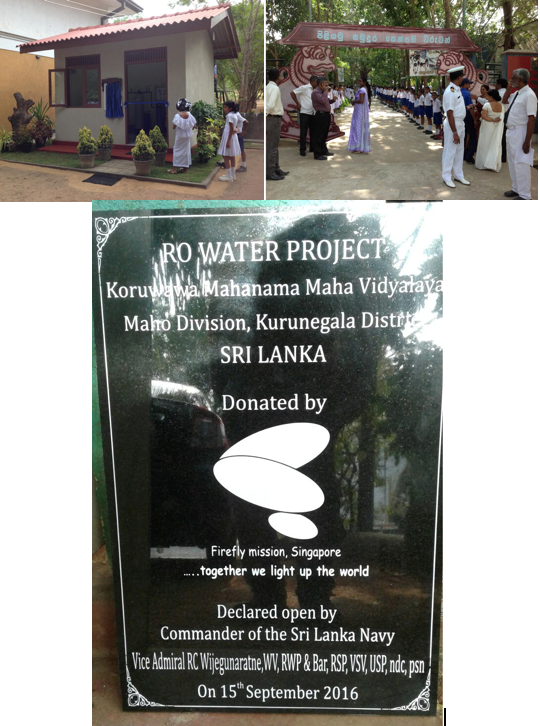
Project 3 – Thirappane Maha, Vidyalaya, Anuradhapura District
- Project approved by FFM Committee on 26 Nov 2016
- Project handover on 4 Jan 2017
- Cost: Sri Lanka Rupiah1,372,070 (S$13,348)
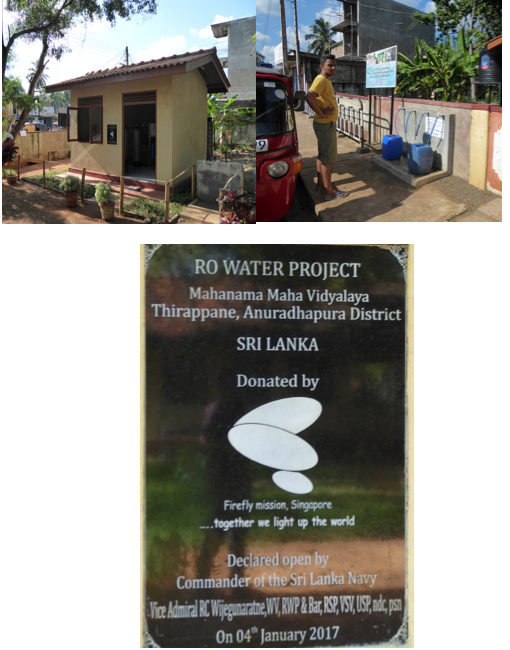
Project 4 – A/Tambuttegama Central Collage, Tambuttegama, Anuradhapura
- Project approved by FFM Committee on 25 Feb 2017
- Project handover on 27 Apr 2017
- Cost Sri Lanka Rupiah 1,372,070 S$(13,036)
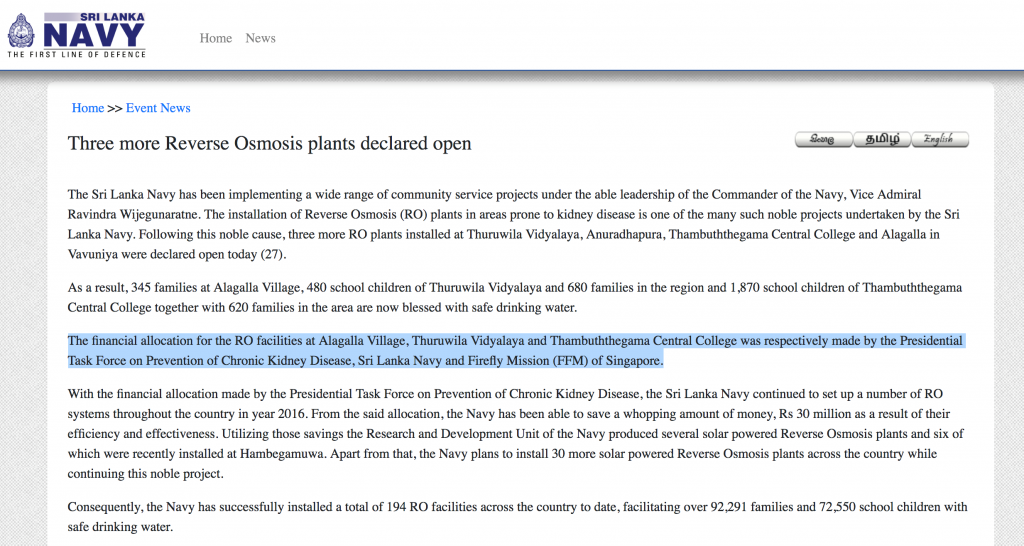
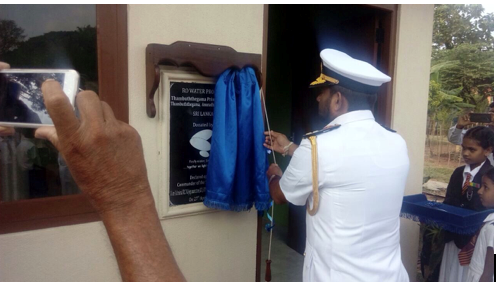
Project 5 – A/Mahabulakulum Maha Vidyalaya, Mahabulakulama, Anuradhapura
- Project approved by FFM Committee on 25 Feb 2017
- Project handover on 28 Apr 2017
- Cost Sri Lanka Rupiah 1,372,070 S$(13,036)
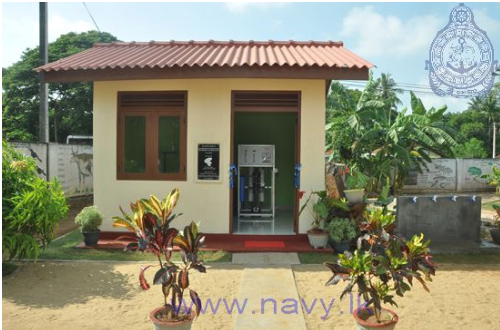
Project 6 – A/Thammanakulum Primary School, Thammannakulm, Mediwachiya, Anuradhapura
- Project approved by FFM Committee on 29 Apr 2017
- Project handover on 4 Jun 2017
- Cost: Sri Lanka Rupiah 1,372,070
- Sponsored by: I/M Patrick Tan Kim Sai
- Cost Sri Lanka Rupiah 1,372,070 S$(12,810)
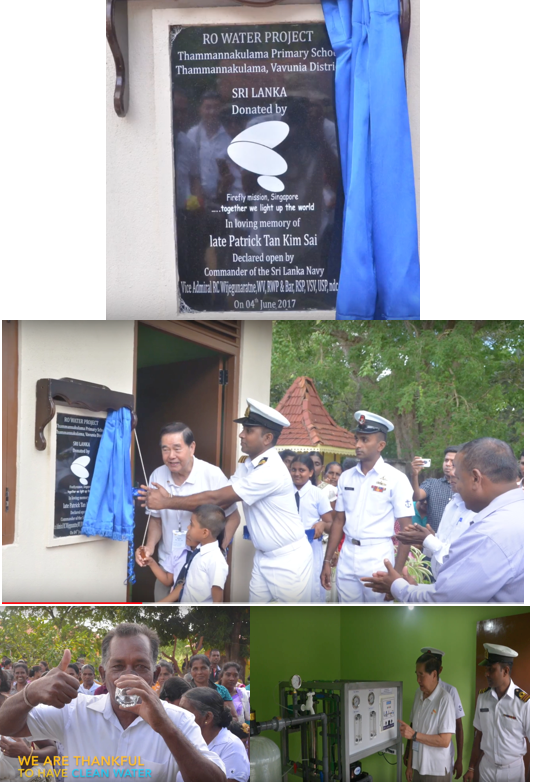
Project 7 -Sri Dharmashrama Buddhist Centre, Mahiyangananya
- Project approved by FFM Committee on 1 Jul 2017
- Project handover on 7 August 2017
- Cost Sri Lanka Rupiah 1,372,070 S$(12,593)
- Sponsored by Dr Ong Chin Kian (Humanitarian with Love)
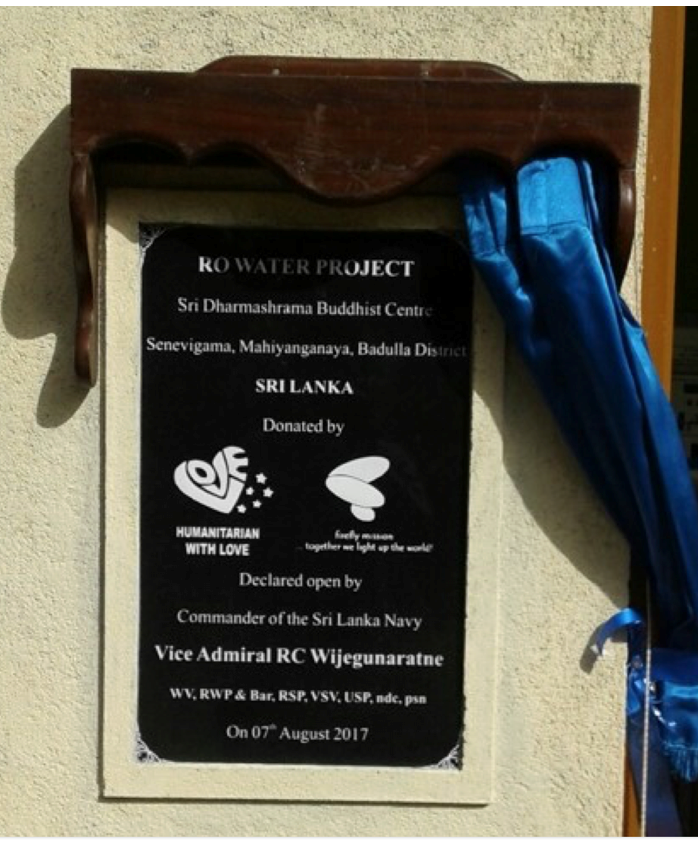
Project 8 -Sri Rajapushparamaya, Makichchawa Morakewa, Anuradhapura Project approved by FFM Committee on 1 Jul 2017
- Project handover on 26 August 2017
- Cost Sri Lanka Rupiah 1,372,070 S$(12,593)
- Sponsored by Sebastian Tan (Wong Chit Sieng, Wong Oi Yong, Wong Keet Mun, Wong Keet Wai and Wong Keet Seng)
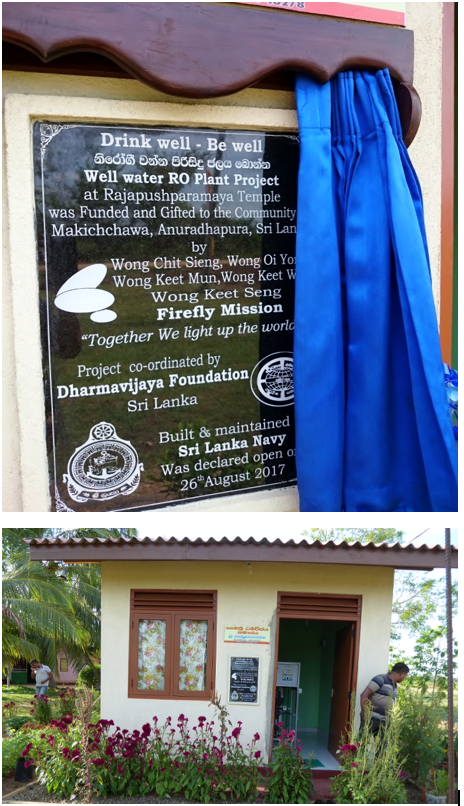
Project 9 -Pahala Diggala Primary School, Dewahuwa, Matale, Dambulla
- Project approved by FFM Committee on 26 Aug 2017
- Project handover on 23 Oct 2017
- Cost Sir Lanka Rupiah 1,372,070 (S$12,190)
- Sponsored by Participants of Sri Lanka Trip 201
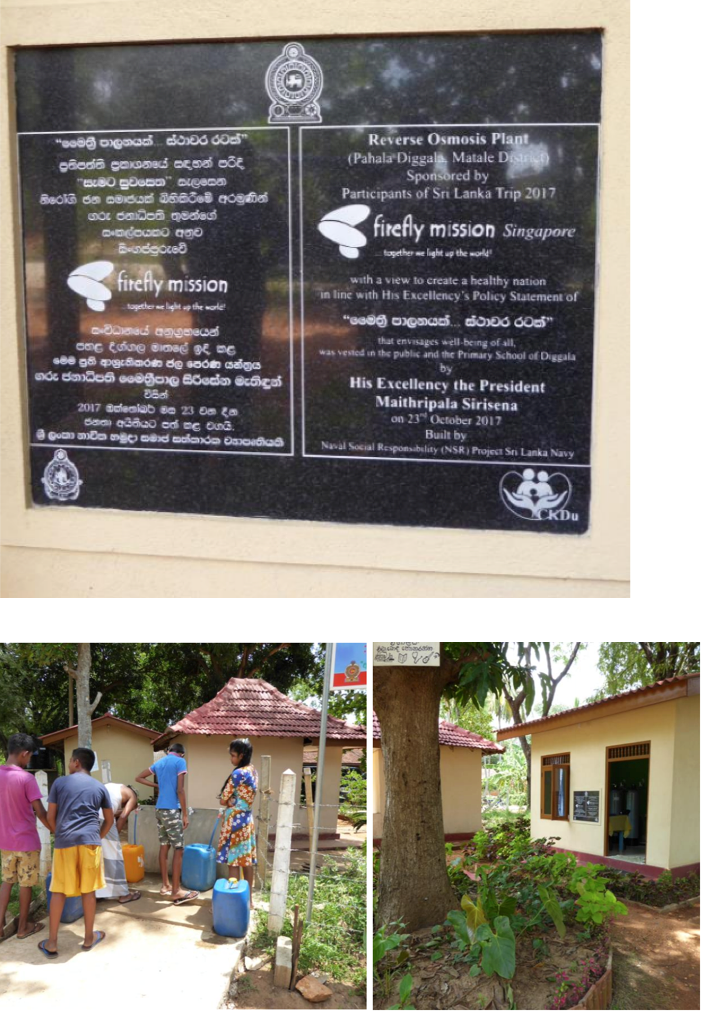
Project 10 -Ucharitha Wardana Wedihiti Samithiya, Marakandawala, Anuradhapura
- Project approved by FFM Committee on 26 Aug 2017
- Project handover on 12 Oct 2017
- Cost Sri Lanka Rupiah 1,372,070 S$(12,349)
- Sponsored by Tan Ju Le & family (Mdm Chuang Hooi Cheng & family)
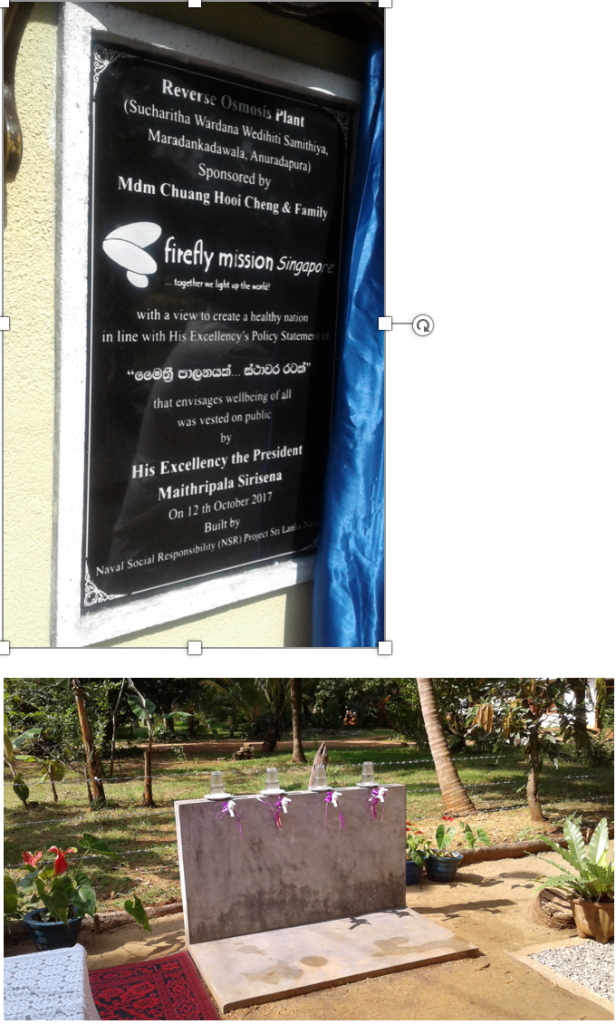
Project 11 -Asiri Kanda Aranya Senasanaya, Kuchaveli, Trincomalee
- Project approved by FFM Committee on 26 Aug 2017
- Project handover on 12 Oct 2017
- Cost Sri Lanka Rupiah 1,372,070 S$(12,349)
- Sponsored by a FFM Member
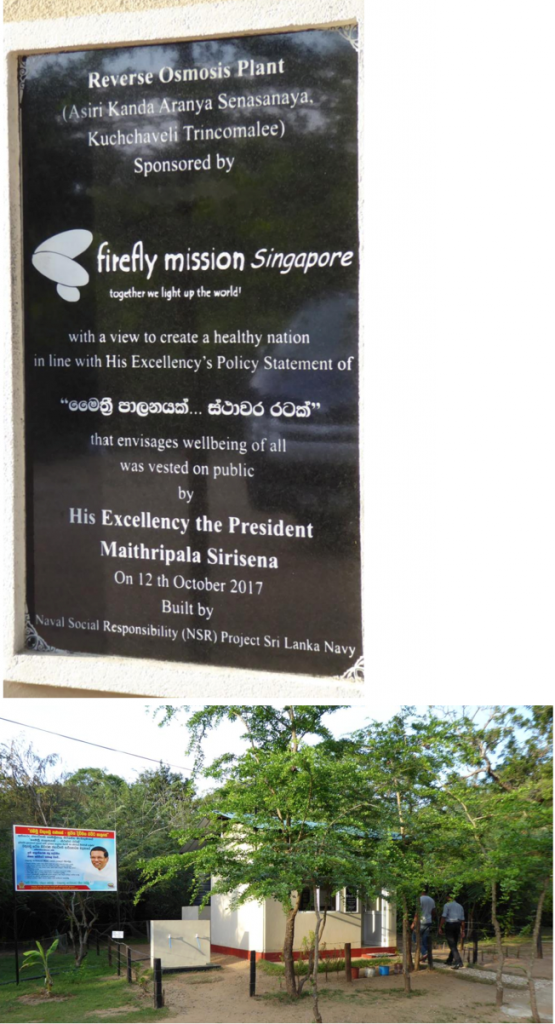
12) Asokaramaya, Medirigiya
- Project handover on 29 Sept 2018
- Benefits: 75 families and 80 students
- Cost Sri Lanka Rupee 1,522,070 S$(13,392)
- Sponsored by IMO Mdm Tan Seok Mai
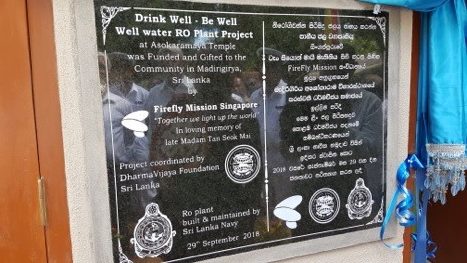
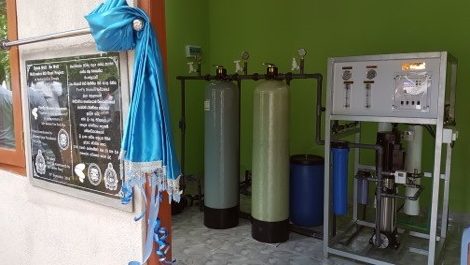

13) Hathareswela Vidyalaya, Saliyapura
- Project handover on TBA
- Benefits: 450 families and 450 students
- Cost Sri Lanka Rupee 1,522,070 S$(13,392)
- Sponsored by the estate of Bro Lee Teng Yong
14) Sri Bodhirukkaramaya, Dunumadalawa
- Project handover on TBA
- Benefits: 200 families and 300 students
- Cost Sri Lanka Rupee 1,522,200 S$(12,995)
- Sponsored by Mr Victor Soh
15)Vidyadarsha Maha Vidyalaya, Nochchiyagama
- Project handover on TBA
- Benefits: 300 families and 200 students
- Cost Sri Lanka Rupee 1,522,070 S$(13,309)
- Sponsored by Friends of Firefly Mission,Singapore
16) Saliyawewa Maha Vidyalaya, Oyamaduwa
- Project handover on TBA
- No of people benefits: 3000
- Cost Sri Lanka Rupee 1,522,070 S$(13,309)
- Sponsored by Amanda Quek Pek Noi, in gratitude to parents and in memory of the late Nancy Sng
B ) Eye Operation Project –
In May 2018, Sis Shuyin proposed the cataract eye operation for Sri Lanka under the Karuna Trust. Karuna Trust is set up by Dr Asela Abeydeera in Sept 2017 to provide cataract eye operation and eye cares. They provide monthly outreach programme in rural area. Those identified with cataract are registered for surgeries at selected hospitals by the charity for free cataract operation. The charity also provide for necessary logistic support such as transport, food and accommodation (usually at temples) for the surgeries and the follow up examination.
Firefly Mission supported the program in 2018 by sponsoring S$10,000 for Jul to Dec 2018 cataract eye operation.




ACKNOWLEDGEMENT
Firefly Mission would like to express its deep gratitude and thanks to all the people who have made this partnership project possible.
- Sis Shuyin Lim, FFM Coordinator for Sri Lanka
- Sis Low Siew Kiang, FFM Coordinator for Sri Lanka
- Sri Lanka Navy
- Karuna Trust
- All donors for Sri Lanka Projects
- Volunteers of Firefly Mission Singapore
- Other well-wishers and volunteers, too numerous to be named
CONTACT INFORMATION
For further information related to this report, please contact:
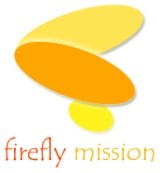
萤火之光
… together we light up the world
Firefly Mission
Website: http://www.fireflymission.org
Email: enquire@fireflymission.org
Report dated 12 Oct 2018 by Michelle Lee
